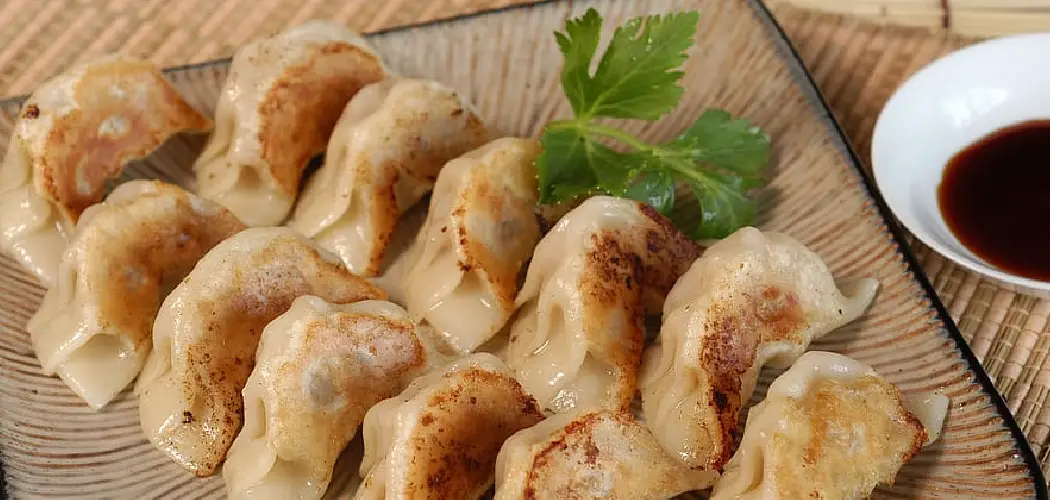Are you looking for an easy way to make delicious, crunchy potstickers that your family will love? If so, then this blog post is just what you need! We’ll show you how to heat up potstickers in a few simple steps with minimal effort. Whether you’re heating up store-bought potstickers or cooking them from scratch, we’ve got all the tips and tricks to help get the perfect result.
From pan-frying or steaming to baking or boiling – there are lots of methods that work great when it comes to making succulent and flavorful potstickers. Get ready for a mouthwatering meal time by learning all about heating up these tasty treats!
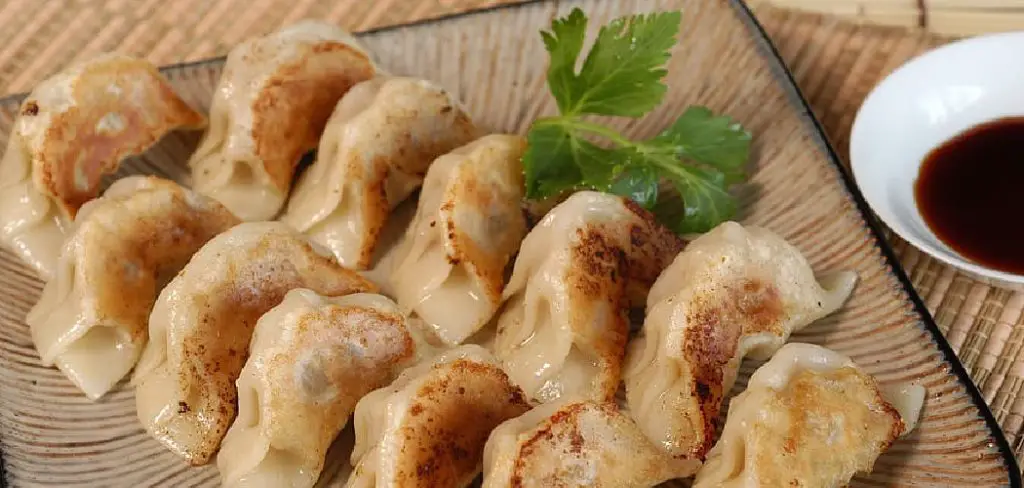
Understanding Potstickers
1. Definition and Origin
Potstickers, also known as ‘guo tie’ in Mandarin Chinese, are a type of pan-fried dumpling that’s a staple in Asian cuisine. They originated from China, tracing their roots back to the Song Dynasty. The unique name ‘potsticker’ is a literal translation of the Chinese term, inspired by the cooking method where the dumplings stick to the wok before being forcefully detached, hence ‘sticking to the pot’.
2. Different Types of Potstickers
There are a plethora of potsticker variations, each reflecting the culinary diversity of different regions. Some of the popular types include the classic ‘jiaozi’ from Northern China, the spicy ‘Sichuan-style’ potstickers, and the crispy ‘goyza,’ a potsticker type that has been Japanized. Each variant offers its own unique blend of flavors and textures.
3. Ingredients Commonly Used in Potstickers
The beauty of potstickers lies in their versatility. The filling often consists of minced meat (pork, chicken, or beef) or vegetables (cabbage, mushrooms, or chives) combined with seasonings like soy sauce, sesame oil, and ginger. The outer wrapper is made from wheat dough. Once assembled, the potstickers are pan-fried until crispy and golden brown, then served with a tangy dipping sauce on the side.
Can You Heat up Potstickers?
Potstickers are a delicious and popular food item many people worldwide enjoy. However, the question on many people’s minds is whether or not it is possible to heat potstickers.
The answer is overwhelmingly positive! Whether using a steamer, microwave, or stovetop, potstickers are versatile food items that can be easily heated without sacrificing their delicious taste.
With just a few simple steps, you can enjoy perfectly heated and crispy potstickers that satisfy your craving for this iconic dish. So, go ahead and give it a try – once you taste those piping hot pot stickers, you’ll be glad you did!
Why Should You Heat up Potstickers?
Potstickers and dumplings are beloved dishes in many cultures. To truly enjoy these delicious morsels, it’s important to heat them properly. Heating potstickers makes them taste better and prevents any potential health issues from bacteria growth when consuming undercooked meat or fillings.
Heating them also helps to soften the outer wrapper, creating the perfect contrast with the tender and juicy filling inside. Whether pan-frying, steaming, or boiling, taking the extra time to heat up your potstickers makes all the difference in taste and safety. Don’t miss out on the full flavor experience – heat your potstickers before indulging in this tasty treat.
Essential Tools and Ingredients for Heating up Potstickers
Before we dive into the methods of heating potstickers, make sure you have all the necessary tools and ingredients on hand. Here’s a list of what you’ll need:
- Steamer basket or steaming tray
- Microwave-safe plate or container
- Non-stick frying pan
- Water
- Cooking oil (preferably vegetable or canola)
- Soy sauce
How to Heat up Potstickers and Keep Them Crispy
1. Steaming Method
The best way to reheat potstickers is to steam them. It retains their flavor, keeps them moist, and prevents them from drying out. Fill a saucepan with enough water and bring it to a boil. Place a steamer basket on the saucepan, ensuring it doesn’t touch the water.
Arrange the potstickers on the steamer basket, leaving enough space between each other. Cover the pan and let the potstickers steam for about 1-2 minutes or until they’re heated through. Once done, remove them from the basket and serve hot with your favorite dipping sauce.
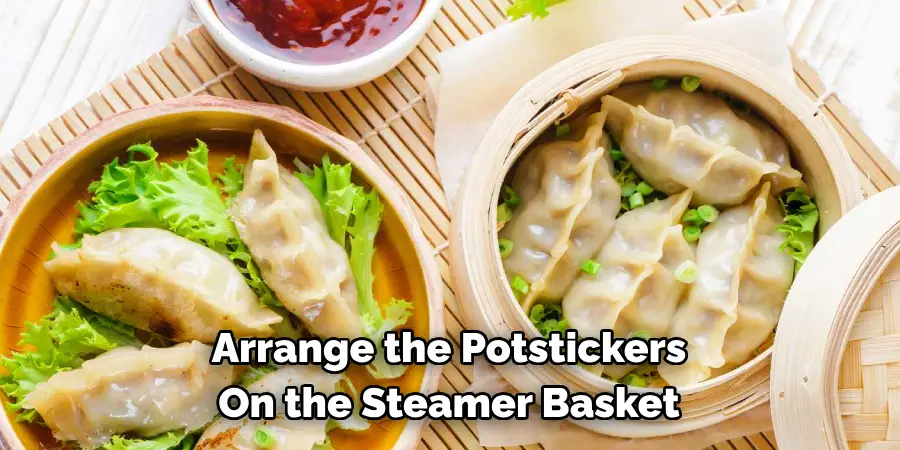
2. Pan-fry Method
Pan-frying potstickers is another excellent way to reheat them. This method will give you that extra crunchiness that comes with the browned bottoms of the dumplings. Heat some oil in a non-stick skillet over medium heat. Once the oil is hot, place the potstickers in a single layer in the pan. Cook for 2-3 minutes until the bottom of the dumplings is golden brown.
Then, add a quarter cup of water and immediately cover the pan with a tight-fitting lid. The water will generate steam and cook the potstickers evenly. After around 3-4 minutes, remove the lid and let the water evaporate. Cook for another 1-2 minutes until the bottoms turn golden brown again. Serve hot.
3. Microwaving
If you’re in a hurry and don’t have time to steam or pan-fry the potstickers, microwaving is a quick fix. Arrange the potstickers on a microwave-safe plate, avoiding overcrowding.
Cover the plate with a microwave-safe bowl. This will trap the steam and prevent the potstickers from drying out. Microwave for 30-45 seconds or until heated through. Once done, remove the bowl and serve hot.
4. Oven Method
This method is especially useful when you have a large batch of potstickers to reheat. Preheat the oven to 350 degrees F. Arrange the potstickers on a baking sheet lined with parchment paper. Do not overcrowd the sheet. Bake for 8-10 minutes or until heated through and the bottoms turn golden brown. Remove the baking sheet from the oven and serve hot.
5. Air-fryer Method
If you have an air fryer, using it to reheat potstickers is one of the easiest and quickest methods. Place the potstickers in a single layer in the air-fryer basket. Cook them at 350°F for 4-5 minutes or until crispy and heated through. Remove the potstickers from the air fryer basket and serve hot.
6. Boiling Method
If you lack cooking equipment, boiling potstickers is another viable option. Fill a saucepan with water and bring it to a boil over medium heat. Add the potstickers to the boiling water and let them cook for 2-3 minutes or until heated. Drain the potstickers using a colander and serve hot.
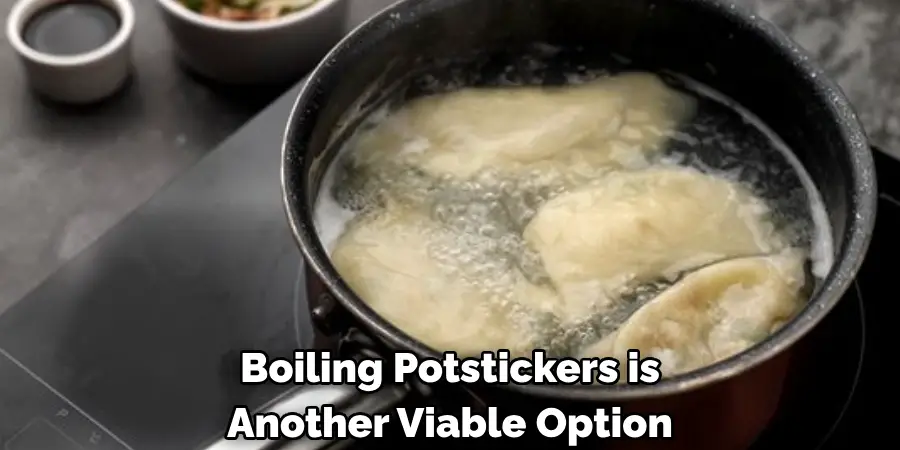
7. Deep Fry Method
Deep-frying is a great way to reheat potstickers, giving them a crunchy texture. Heat enough oil in a deep-fryer or saucepan over medium heat. Once the oil is hot, add the potstickers in batches and fry for 1-2 minutes or until crisp and golden brown. Remove the potstickers with a slotted spoon and place them on a plate lined with paper towels to absorb any excess oil. Serve hot.
Reheating potstickers is easy and quick as long as you know the method. Whether steaming, pan-frying, microwaving, oven baking, air-frying, boiling, or deep-frying, each method will guarantee you delicious hot potstickers. What are you waiting for? Get cooking!
Some Considerations Things When You Need to Heat up Potstickers
Potstickers make for a delicious appetizer or snack, but heating them can be tricky. Since potstickers are typically filled with a savory mixture of meat and vegetables, you don’t want to overcook them and lose their juicy goodness. One consideration to keep in mind when heating potstickers is the cooking method. While some prefer the traditional pan-frying method, others prefer steaming or microwaving.
Another consideration is the heat and cooking time needed to get your potstickers to the perfect temperature. You’ll want to use caution and avoid leaving them in the pan or microwave for too long, which can result in tough, chewy potstickers that will disappoint your taste buds.
With a little bit of patience and some careful attention to these key considerations, you can easily heat up your potstickers to perfection and enjoy all the deliciousness they offer.
5 Benefits of Heat-up Potstickers Heat-up Potstickers
1. Quick and Easy to Make
One of the best things about heat-up potstickers is that they are quick and easy to make. All you need to do is pop them in the microwave for a few minutes, and they’re ready to eat. This makes them perfect for busy weeknights when you don’t have time to cook a full meal.
2. Affordable
Another great thing about heat-up potstickers is that they are very affordable. A package usually costs less than $5, making them a great budget-friendly option.
3. Versatile
Heat-up potstickers are versatile and can be enjoyed as a main or side dish. They can be served with rice and vegetables for a complete meal or eaten on their own as a quick snack.
4. Delicious
Of course, one of the best things about heat-up potstickers is their deliciousness! They are packed with flavor and are sure to satisfy your hunger.
5. Convenient
Last but not least, heat-up potstickers are extremely convenient. They can be stored in the freezer for months, so always have them on hand when needed. Plus, they’re easy to take on the go, making them perfect for busy lifestyles.
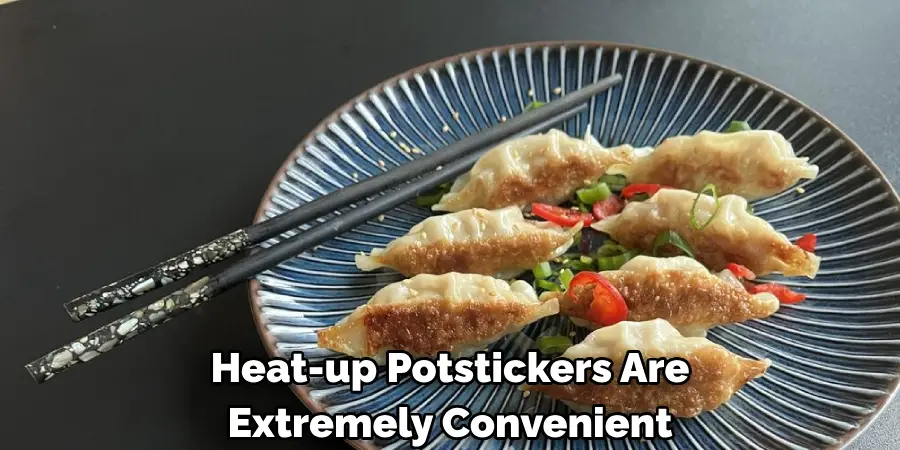
So, get ready to enjoy all the deliciousness that heat-up potstickers offer! With a few simple steps and considerations, you can easily prepare them in no time and reap all the amazing benefits they offer. Bon appetite!
Some Common Mistakes People Make When Trying to Heat up Potstickers
Potstickers are a delicious and easy-to-make snack that can be enjoyed any time of the year. However, many people often make common mistakes when heating them. One of the most common mistakes is cooking them on high heat, resulting in burnt and crispy bottoms.
Another mistake is overcrowding the pan, which can cause the potstickers to steam instead of frying, leading to a soggy texture. Lastly, some people forget to add a little oil to the pan, resulting in the potstickers sticking to the surface and falling apart. With a little care and attention, you can avoid these common mistakes and enjoy perfectly crispy and delicious potstickers every time.
Ideas for Incorporating Potstickers Into Other Dishes
Idea 1: Potsticker Salad
Mix together diced cooked potstickers with lettuce, bell peppers, and other vegetables for a filling salad. Drizzle your favorite dressing on top for an extra boost of flavor!
Idea 2: Potsticker Soup
Create a savory soup by adding cooked potstickers to the broth and simmering until heated through. You can also add noodles, vegetables, and mushrooms for an even heartier soup.
Idea 3: Potsticker Fried Rice
Mix cooked potstickers with cooked rice, scrambled eggs, and vegetables for a delicious fried rice dish. Sprinkle on some soy sauce or other seasonings for added flavor!
Idea 4: Potsticker Quesadillas
Stuff-cooked potstickers into a quesadilla for an easy and delicious meal. Add in your favorite cheese, vegetables, and spices for an extra boost of flavor!
Idea 5: Potsticker Tacos
Substitute traditional taco shells with cooked potstickers and fill them with your favorite taco ingredients. Top them off with sour cream, hot sauce, and other condiments for a fun twist on tacos.
Idea 6: Potsticker Pizza
Spread cooked potstickers over pizza dough, along with your favorite sauce, cheese, and vegetables. Bake in the oven until golden brown and bubbly for an easy gourmet meal!
Idea 7: Potsticker Wraps
Fill a wrap with cooked potstickers, lettuce, tomato, and your favorite condiments for a flavorful lunch. Serve with chips or a side salad for an even heartier meal.
Idea 8: Potsticker Nachos
Sprinkle cooked potstickers over tortilla chips and then top with cheese, beans, tomatoes, onions, peppers, and other toppings. Bake until the cheese is melted and bubbly for a delicious nacho treat!
No matter how you choose to enjoy them, potstickers can be a tasty and convenient addition to any meal. With these eight ideas for incorporating potstickers into other dishes, you’re sure to find one that will satisfy your taste buds!
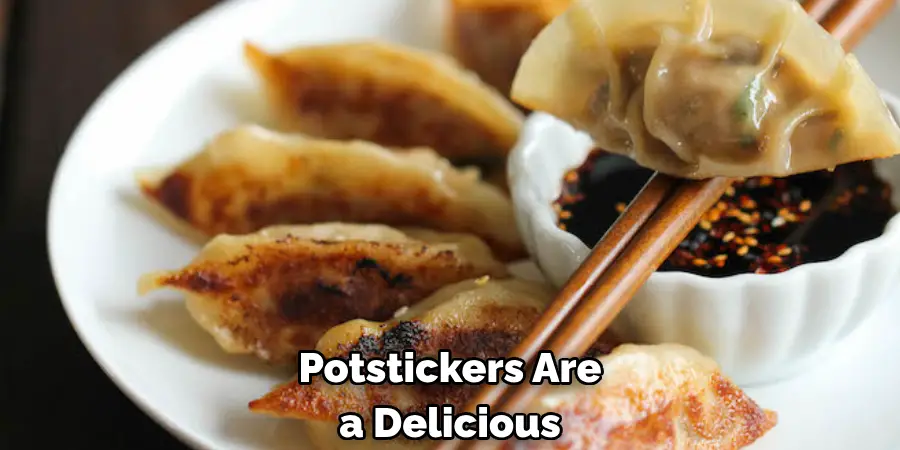
Ideas for Spicing up Standard Heat-Up Potstickers with Various Seasonings and Flavorings
Idea 1: Sweet and Sour
For a sweet and sour flavor, combine 1/4 cup of sugar, 1/2 cup of vinegar, two cloves of garlic (minced), and some red pepper flakes in a small saucepan over medium-high heat. Simmer the mixture for 10 minutes until it is reduced by half. Serve the potstickers with the sweet and sour sauce.
Idea 2: Honey and Sesame
For a honey and sesame flavor, mix together 1/4 cup of honey, 1 tablespoon of sesame oil, two tablespoons of soy sauce, and some red pepper flakes in a small bowl. Heat the potstickers in a pan over medium-high heat and add the honey and sesame mixture to the pan. Stir the potstickers until they are coated in the mixture and cook for an additional minute. Serve with extra honey and sesame on top.
Idea 3: Spicy Thai Chili
For a spicy Thai flavor, mix together 1/4 cup of lime juice, two tablespoons of fish sauce, one tablespoon of sugar, and one teaspoon of chili flakes in a small bowl. Heat the potstickers in a pan over medium-high heat and add the Thai chili mixture to the pan. Stir the potstickers until they are coated in the mixture, and cook for an additional minute. Serve with extra lime wedges, cilantro, and chili flakes on top.
Idea 4: Teriyaki
For a teriyaki flavor, mix together 1/4 cup of soy sauce, two tablespoons of mirin (rice wine), two teaspoons of sugar, and one teaspoon of sesame oil in a small bowl. Heat the potstickers in a pan over medium-high heat and add the teriyaki mixture to the pan. Stir the potstickers until they are coated in the mix, and cook for an additional minute. Serve with extra soy sauce, sesame seeds, and green onions on top.
So, get creative and have fun! With these ideas for spicing up standard heat-up potstickers with various seasonings and flavorings, your taste buds are sure to be satisfied. Enjoy!
How to Freeze Potstickers
Freezing potstickers is an easy way to preserve them for future use. To freeze potstickers, start by placing them on a baking sheet in the freezer. Make sure they are spread out and not touching each other, as this will help prevent them from sticking together when frozen. Once the potstickers have been in the freezer for about two hours, transfer them to a freezer-safe bag or container and store them in the freezer for up to three months. When you’re ready to enjoy your potstickers, heat them in the microwave or on the stovetop.
Freezing potstickers is also an easy way to save time when cooking. Prepare a large batch of potstickers and freeze them in single-serving portions. This way, you can grab one portion from the freezer when needed and heat it up quickly for a delicious meal. Enjoy!
Enhancing Flavor with Dipping Sauces
Potstickers are delightful on their own, but pairing them with a flavorful dipping sauce can elevate the dining experience.
1. Popular Dipping Sauce Recipes
- Soy-Ginger Sauce: Combine 1/2 cup soy sauce, two tablespoons of minced fresh ginger, one minced garlic clove, two tablespoons of rice vinegar, and one teaspoon of sesame oil. Stir well to incorporate the flavors.
- Sweet Chili Sauce: Mix 1/2 cup of sweet chili sauce with one tablespoon of soy sauce and one tablespoon of lime juice. Add a dash of hot sauce if you prefer some heat.
- Hoisin-Peanut Sauce: Blend 1/2 cup of hoisin sauce, two tablespoons of peanut butter, one tablespoon of rice vinegar, and a dash of chili flakes.
2. Complementary Flavors for Different Potsticker Fillings
Different potsticker fillings can be enhanced by matching them with the right dipping sauce. For meat-filled potstickers like pork or beef, a robust sauce like the Hoisin-Peanut Sauce works wonders. For seafood or vegetable potstickers, something lighter, like the Soy-Ginger Sauce, complements the filling without overpowering it.
3. Tips for Balancing Sweet, Salty, and Umami Flavors
The art of creating the perfect dipping sauce lies in balancing essential taste elements: sweet, salty, and umami. Here are some tips:
- For sweetness, consider adding a touch of honey or sugar to your sauce recipe.
- Increase the saltiness by adding more soy sauce or a pinch of salt.
- Boost umami flavors with ingredients rich in glutamate, like soy sauce, tomatoes, mushrooms, or a sprinkle of MSG.
Remember, the key to a successful sauce is to taste as you go and adjust the seasonings to match your preference. Enjoy the rich, complex flavors that these sauces bring to your potstickers!
Frequently Asked Questions
Q1: Can I use a different filling for potstickers?
A1: Absolutely! Potstickers are versatile, and you can experiment with various fillings. Traditional fillings include pork, cabbage, and chives. However, you can also use ground chicken, tofu, or even a combination of different vegetables.
Q2: Is it possible to make vegetarian potstickers?
A2: Yes, you can make vegetarian potstickers. Substitute the meat with finely chopped vegetables such as cabbage, carrots, mushrooms, and tofu.
Q3: Can I pan-fry the frozen potstickers directly?
A3: Yes, frozen potstickers can be cooked directly without thawing. They might require a slightly longer cooking time compared to fresh ones.
Q4: What is the best way to reheat leftover potstickers?
A4: The best way to reheat leftover potstickers is by pan-frying them. This method helps to retain the crispy texture of the potsticker wrapper.
Q5: How long can I store leftover potstickers in the refrigerator?
A5: Leftover cooked potstickers can be stored in the refrigerator for up to 3-4 days. Make sure they are stored in airtight containers to retain their freshness.
Conclusion
Potstickers are a delicious delight, and knowing how to reheat them can make a difference in your dish experience. Each of the methods we have discussed offers its unique advantages.
Whether you steam, pan-fry, microwave, oven, or air fry them, remember to keep them moist and preserve their texture. Try these methods, and you’ll enjoy crispy, delicious potstickers like a pro! Thanks for reading our post about how to heat up potstickers.
You Can Check it Out to Heat up Bao Buns

